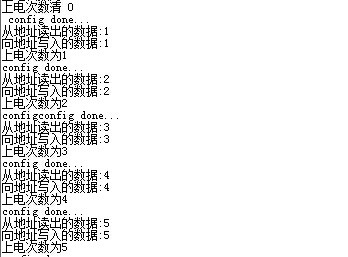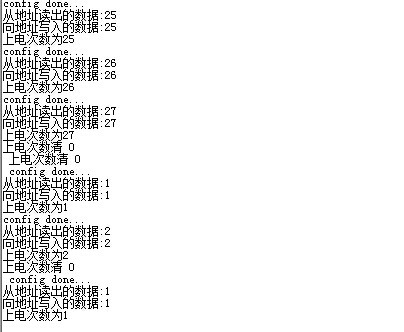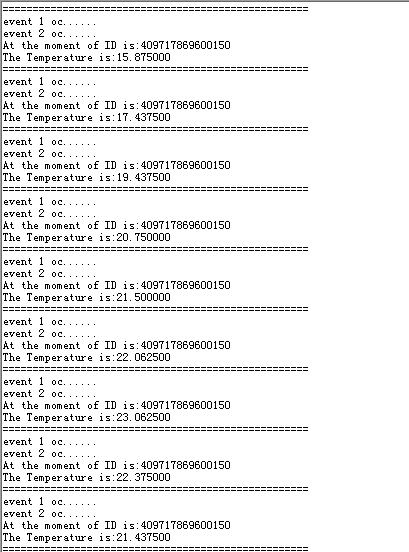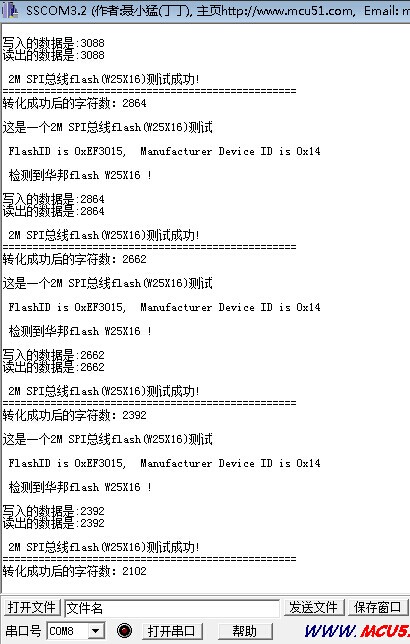ADC-PWM-RGB-RGB
为了看到明显变化所以分了四种情况
密码:12
/** ****************************************************************************** * @file EXTI/EXTI_Config/main.c * @author MCD Application Team * @version V3.5.0 * @date 08-April-2011 * @brief Main program body ****************************************************************************** * @attention * * THE PRESENT FIRMWARE WHICH IS FOR GUIDANCE ONLY AIMS AT PROVIDING CUSTOMERS * WITH CODING INFORMATION REGARDING THEIR PRODUCTS IN ORDER FOR THEM TO SAVE * TIME. AS A RESULT, STMICROELECTRONICS SHALL NOT BE HELD LIABLE FOR ANY * DIRECT, INDIRECT OR CONSEQUENTIAL DAMAGES WITH RESPECT TO ANY CLAIMS ARISING * FROM THE CONTENT OF SUCH FIRMWARE AND/OR THE USE MADE BY CUSTOMERS OF THE * CODING INFORMATION CONTAINED HEREIN IN CONNECTION WITH THEIR PRODUCTS. * * <h2><center>© COPYRIGHT 2011 STMicroelectronics</center></h2> ****************************************************************************** */ /* Includes ------------------------------------------------------------------*/ #include "stm32f10x.h" #include "stm32_eval.h" #include <stdio.h> #define VREF 3.3 /** @addtogroup STM32F10x_StdPeriph_Examples * @{ */ /** @addtogroup EXTI_Config * @{ */ /* Private typedef -----------------------------------------------------------*/ /* Private define ------------------------------------------------------------*/ /* Private macro -------------------------------------------------------------*/ /* Private variables ---------------------------------------------------------*/ GPIO_InitTypeDef GPIO_InitStructure; USART_InitTypeDef USART_InitStructure; USART_ClockInitTypeDef USART_ClockInitStructure; void RCC_Configuration(void) {/* RCC_DeInit(); RCC_HSICmd(ENABLE); while(RCC_GetFlagStatus(RCC_FLAG_HSIRDY) == RESET); RCC_SYSCLKConfig(RCC_SYSCLKSource_HSI); RCC_HSEConfig(RCC_HSE_OFF); RCC_LSEConfig(RCC_LSE_OFF); RCC_PLLConfig(RCC_PLLSource_HSI_Div2,RCC_PLLMul_9); // 72HMz RCC_PLLCmd(ENABLE); while(RCC_GetFlagStatus(RCC_FLAG_PLLRDY) == RESET); RCC_ADCCLKConfig(RCC_PCLK2_Div4); RCC_PCLK2Config(RCC_HCLK_Div1); RCC_PCLK1Config(RCC_HCLK_Div2); RCC_HCLKConfig(RCC_SYSCLK_Div1); RCC_SYSCLKConfig(RCC_SYSCLKSource_PLLCLK); while(RCC_GetSYSCLKSource() != 0x08); */ SystemInit(); RCC_APB2PeriphClockCmd(RCC_APB2Periph_GPIOD|RCC_APB2Periph_AFIO, ENABLE); GPIO_PinRemapConfig(GPIO_Remap_SWJ_JTAGDisable,ENABLE);//disable JTAG RCC_APB2PeriphClockCmd(RCC_APB2Periph_GPIOD|RCC_APB2Periph_AFIO, ENABLE); GPIO_PinRemapConfig(GPIO_Remap_SWJ_JTAGDisable,ENABLE);//disable JTAG GPIO_InitStructure.GPIO_Pin = GPIO_Pin_2; GPIO_InitStructure.GPIO_Speed = GPIO_Speed_50MHz; GPIO_InitStructure.GPIO_Mode = GPIO_Mode_Out_PP; GPIO_Init(GPIOD, &GPIO_InitStructure); GPIO_ResetBits(GPIOD,GPIO_Pin_2); RCC_APB2PeriphClockCmd(RCC_APB2Periph_GPIOC|RCC_APB2Periph_AFIO, ENABLE); GPIO_PinRemapConfig(GPIO_Remap_SWJ_JTAGDisable,ENABLE);//disable JTAG GPIO_InitStructure.GPIO_Pin = GPIO_Pin_0|GPIO_Pin_1|GPIO_Pin_2|GPIO_Pin_3|GPIO_Pin_4|GPIO_Pin_5|GPIO_Pin_6|GPIO_Pin_7; GPIO_InitStructure.GPIO_Speed = GPIO_Speed_50MHz; GPIO_InitStructure.GPIO_Mode = GPIO_Mode_Out_PP; GPIO_Init(GPIOC, &GPIO_InitStructure); GPIO_SetBits(GPIOC,GPIO_Pin_0|GPIO_Pin_1|GPIO_Pin_2|GPIO_Pin_3|GPIO_Pin_4|GPIO_Pin_5|GPIO_Pin_6|GPIO_Pin_7); RCC_APB1PeriphClockCmd(RCC_APB1Periph_TIM2, ENABLE); } void USART_int(long BaudRate) { RCC_APB2PeriphClockCmd(RCC_APB2Periph_GPIOA|RCC_APB2Periph_USART1,ENABLE); GPIO_InitStructure.GPIO_Pin = GPIO_Pin_9; GPIO_InitStructure.GPIO_Speed = GPIO_Speed_10MHz; GPIO_InitStructure.GPIO_Mode = GPIO_Mode_AF_PP; GPIO_Init(GPIOA, &GPIO_InitStructure); /* PA10 USART1_Rx */ GPIO_InitStructure.GPIO_Pin = GPIO_Pin_10; GPIO_InitStructure.GPIO_Mode = GPIO_Mode_IN_FLOATING; GPIO_Init(GPIOA, &GPIO_InitStructure); /* USARTx configured as follow: - BaudRate = 115200 baud - Word Length = 8 Bits - One Stop Bit - No parity - Hardware flow control disabled (RTS and CTS signals) - Receive and transmit enabled */ USART_InitStructure.USART_BaudRate = BaudRate;//?????? USART_InitStructure.USART_WordLength = USART_WordLength_8b;//???????8bit USART_InitStructure.USART_StopBits = USART_StopBits_1;//????1 USART_InitStructure.USART_Parity = USART_Parity_No;//???? USART_InitStructure.USART_HardwareFlowControl = USART_HardwareFlowControl_None;//??????none USART_InitStructure.USART_Mode = USART_Mode_Rx | USART_Mode_Tx;//?????????? USART_ClockInitStructure.USART_Clock = USART_Clock_Disable; USART_ClockInitStructure.USART_CPOL = USART_CPOL_Low; USART_ClockInitStructure.USART_CPHA = USART_CPHA_2Edge; USART_ClockInitStructure.USART_LastBit = USART_LastBit_Disable; USART_ClockInit(USART1, &USART_ClockInitStructure); USART_Init(USART1, &USART_InitStructure); USART_Cmd(USART1, ENABLE); USART_ITConfig(USART1, USART_IT_RXNE, ENABLE); USART_Cmd(USART1, ENABLE); } void delay_us(u32 n) { u8 j; while(n--) for(j=0;j<10;j++); } void delay_ms(u32 n) { while(n--) delay_us(1000); } void PWM_Config() {uint16_t PrescalerValue = 0; TIM_TimeBaseInitTypeDef TIM_TimeBaseStructure; TIM_OCInitTypeDef TIM_OCInitStructure; /* TIM2 clock enable */ RCC_APB1PeriphClockCmd(RCC_APB1Periph_TIM2, ENABLE); /* GPIOA enable */ RCC_APB2PeriphClockCmd(RCC_APB2Periph_AFIO , ENABLE); GPIO_InitStructure.GPIO_Pin = GPIO_Pin_1|GPIO_Pin_2|GPIO_Pin_3; GPIO_InitStructure.GPIO_Mode = GPIO_Mode_AF_PP; GPIO_InitStructure.GPIO_Speed = GPIO_Speed_50MHz; GPIO_Init(GPIOA, &GPIO_InitStructure); TIM_Cmd(TIM2, ENABLE); /* Compute the prescaler value */ PrescalerValue = (uint16_t) (SystemCoreClock / 24000000) - 1; /* Time base configuration */ TIM_TimeBaseStructure.TIM_Period = 0x07FF; TIM_TimeBaseStructure.TIM_Prescaler = PrescalerValue; TIM_TimeBaseStructure.TIM_ClockDivision = 0; TIM_TimeBaseStructure.TIM_CounterMode = TIM_CounterMode_Up; TIM_TimeBaseInit(TIM2, &TIM_TimeBaseStructure); TIM_OCInitStructure.TIM_OCMode = TIM_OCMode_PWM1; TIM_OCInitStructure.TIM_OCPolarity = TIM_OCPolarity_High; /* PWM1 Mode configuration: Channel2 */ TIM_OCInitStructure.TIM_OutputState = TIM_OutputState_Enable; TIM_OCInitStructure.TIM_Pulse = 0xFFFF; TIM_OC2Init(TIM2, &TIM_OCInitStructure); /* PWM1 Mode configuration: Channel3 */ TIM_OCInitStructure.TIM_OutputState = TIM_OutputState_Enable; TIM_OCInitStructure.TIM_Pulse = 0xFFFF; TIM_OC3Init(TIM2, &TIM_OCInitStructure); /* PWM1 Mode configuration: Channel4 */ TIM_OCInitStructure.TIM_OutputState = TIM_OutputState_Enable; TIM_OCInitStructure.TIM_Pulse = 0xFFFF; TIM_OC4Init(TIM2, &TIM_OCInitStructure); TIM_ARRPreloadConfig(TIM2, ENABLE); } void ADC_CONFIG(){ ADC_InitTypeDef ADC_InitStructure; #if defined (STM32F10X_LD_VL) || defined (STM32F10X_MD_VL) || defined (STM32F10X_HD_VL) /* ADCCLK = PCLK2/2 */ RCC_ADCCLKConfig(RCC_PCLK2_Div2); #else /* ADCCLK = PCLK2/4 */ RCC_ADCCLKConfig(RCC_PCLK2_Div4); #endif ADC_DeInit(ADC1); /* Enable ADC1 and GPIOC clock */ RCC_APB2PeriphClockCmd(RCC_APB2Periph_ADC1 | RCC_APB2Periph_GPIOB, ENABLE); /* Configure PB0 (ADC Channel14) as analog input -------------------------*/ GPIO_InitStructure.GPIO_Pin = GPIO_Pin_0; GPIO_InitStructure.GPIO_Mode = GPIO_Mode_AIN; GPIO_Init(GPIOB, &GPIO_InitStructure); /* ADC1 configuration ------------------------------------------------------*/ ADC_InitStructure.ADC_Mode = ADC_Mode_Independent; ADC_InitStructure.ADC_ScanConvMode = ENABLE; ADC_InitStructure.ADC_ContinuousConvMode = ENABLE; ADC_InitStructure.ADC_ExternalTrigConv = ADC_ExternalTrigConv_None; ADC_InitStructure.ADC_DataAlign = ADC_DataAlign_Right; ADC_InitStructure.ADC_NbrOfChannel = 1; ADC_Init(ADC1, &ADC_InitStructure); /* Enable ADC1 DMA */ ADC_DMACmd(ADC1, ENABLE); /* Enable ADC1 */ ADC_Cmd(ADC1, ENABLE); } int Get_ADC(){ /* ADC1 regular channel configuration */ ADC_RegularChannelConfig(ADC1, ADC_Channel_8, 1, ADC_SampleTime_55Cycles5); /* Enable ADC1 reset calibration register */ ADC_ResetCalibration(ADC1); /* Check the end of ADC1 reset calibration register */ while(ADC_GetResetCalibrationStatus(ADC1)); /* Start ADC1 calibration */ ADC_StartCalibration(ADC1); /* Check the end of ADC1 calibration */ while(ADC_GetCalibrationStatus(ADC1)); /* Start ADC1 Software Conversion */ ADC_SoftwareStartConvCmd(ADC1, ENABLE); return ADC_GetConversionValue(ADC1); } void PWM_TEST() { float Volt=0.00; unsigned int temp0,temp1,temp2,ADValue = 0; while(1) { ADValue = Get_ADC(); Volt = VREF*ADValue/4095; printf("===============================\r\n"); printf("The ADC value is:%d\r\n",ADValue); printf("The Volt is:%f V\r\n",Volt); TIM_SetCompare2(TIM2, temp0); TIM_SetCompare3(TIM2, temp1); TIM_SetCompare4(TIM2, temp2); if(ADValue>3000) { temp0=ADValue/2-1300;temp1=ADValue/2-700;temp2=ADValue/2-150; }if(2000<ADValue<=3000) { temp0=ADValue/2-300;temp1=ADValue/2-900;temp2=ADValue/2-50; }if(1000<ADValue<=2000) { temp0=ADValue/2+900;temp1=ADValue/2;temp2=ADValue/2-500; }if(ADValue<=1000) { temp0=ADValue+100;temp1=ADValue+600;temp2=ADValue+1000; } delay_ms(50); } } /* Private functions ---------------------------------------------------------*/ /** * @brief Main program. * @param None * @retval None */ int main(void) { RCC_Configuration(); USART_int(115200); ADC_CONFIG(); printf(" config done...\r\n"); Get_ADC(); PWM_Config(); delay_ms(200); while(1) { PWM_TEST(); } } #ifdef USE_FULL_ASSERT /** * @brief Reports the name of the source file and the source line number * where the assert_param error has occurred. * @param file: pointer to the source file name * @param line: assert_param error line source number * @retval None */ void assert_failed(uint8_t* file, uint32_t line) { /* User can add his own implementation to report the file name and line number, ex: printf("Wrong parameters value: file %s on line %d\r\n", file, line) */ /* Infinite loop */ while (1) { } } #endif /** * @} */ /** * @} */ #ifdef __GNUC__ /* With GCC/RAISONANCE, small printf (option LD Linker->Libraries->Small printf set to 'Yes') calls __io_putchar() */ #define PUTCHAR_PROTOTYPE int __io_putchar(int ch) #else #define PUTCHAR_PROTOTYPE int fputc(int ch, FILE *f) #endif /* __GNUC__ */ /** * @brief Retargets the C library printf function to the USART. * @param None * @retval None */ PUTCHAR_PROTOTYPE { /* Place your implementation of fputc here */ /* e.g. write a character to the USART */ USART_SendData(EVAL_COM1, (uint8_t) ch); /* Loop until the end of transmission */ while (USART_GetFlagStatus(EVAL_COM1, USART_FLAG_TC) == RESET) {} return ch; } #ifdef USE_FULL_ASSERT /** * @brief Reports the name of the source file and the source line number * where the assert_param error has occurred. * @param file: pointer to the source file name * @param line: assert_param error line source number * @retval None */ void assert_failed(uint8_t* file, uint32_t line) { /* User can add his own implementation to report the file name and line number, ex: printf("Wrong parameters value: file %s on line %d\r\n", file, line) */ /* Infinite loop */ while (1) { } } #endif /******************* (C) COPYRIGHT 2011 STMicroelectronics *****END OF FILE****/






 我要赚赏金
我要赚赏金

